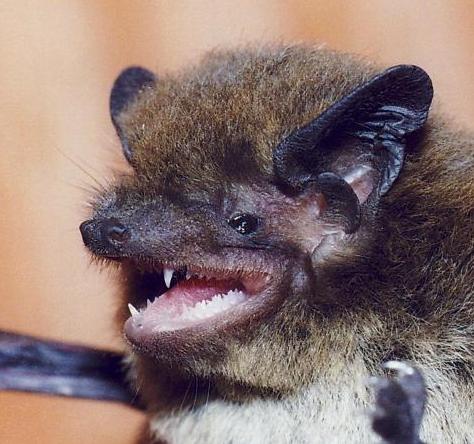Nathusius’s pipistrelles fly in November!
Text and photo: Matti Masing, Sicista Development Centre www.hot.ee/sicista98/
Translation: Liis
Portrait of Nathusius’s pipistrelle
This summer and autumn I investigated the flight activity and distribution of bats in Läänemaa with a Pettersson D240x detector. At the counting routes in Haapsalu many species of bats were flying until the end of October; all species were identified by detector on the basis of their calls. As time passed ever fewer places where bats were flying remained in the town; finally I only found them in a small area at the end of the beach park.
With air temperatures above +6 C insects still flew in Haapsalu up to the end of October; during those nights bats were also flying. Sedentary species were the Northern pipistrelle (Eptesicus nilssonii), Daubenton’s bat (Myotis daubentonii) and the brown long-eared bat (Plecotus auritus), migratory species the Nathusius’s pipistrelle (Pipistrellus nathusii).
When insects were no longer seen around the street lights the bats also disappeared from the air.
An interesting discovery was made on November 8 in the evening at about 7 pm: several Nathusius’s pipistrelles were flying in Haapsalu. The latest finds in autumn of this migratory species have previously been known in the first week of October from Tartu and some coastal areas, after that they are not found in Estonia until the end of April or early May.(depending on the year and place of observation). In the evening of October 17th, at an air temperature of +7.5 C, a single Northern bat was still circling above the Haapsalu beach park; other bat species had then already disappeared from the air..
I expect that this little group of Nathusius’s pipistrelles will stay in Haapsalu to hibernate until spring.
In the western Estonian maritime climate there may also be other places where migratory bats fly in autumn before snow arrives (e g Kuressaare, Kärdla). These places can be relatively easily identified with a detector study but the shelters of the bats are very difficult to find with a detector. Evidently these bats stay here the whole winter and evidently they winter in buildings (migrant species have never been found in underground shelters such as cellars and caves in Estonia).
The Nathusius’s pipistrelle is the second migratory species which is known to winter in Estonia (if it is here in November it generally no longer feeds; consequently it hibernates).
Last winter a particoloured bat (Vespertilio murinus) appeared in Tallinn and another one in Tartu.
Research up to now and other information gathered suggests that relatively few individuals of the migrating species stay in Estonia to hibernate; the majority of them fly south for winter.









